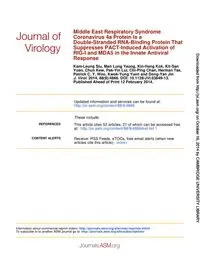
2014 Middle East Respiratory Syndrome Coronavirus 4a Protein Is a Double-Stranded RNA-Binding Protein That Suppresses PA PDF
Preview 2014 Middle East Respiratory Syndrome Coronavirus 4a Protein Is a Double-Stranded RNA-Binding Protein That Suppresses PA
Published Ahead of Print 12 February 2014. 2014, 88(9):4866. DOI: 10.1128/JVI.03649-13. J. Virol. Patrick C. Y. Woo, Kwok-Yung Yuen and Dong-Yan Jin Yuen, Chun Kew, Pak-Yin Lui, Chi-Ping Chan, Herman Tse, Kam-Leung Siu, Man Lung Yeung, Kin-Hang Kok, Kit-San Response RIG-I and MDA5 in the Innate Antiviral Suppresses PACT-Induced Activation of Double-Stranded RNA-Binding Protein That Coronavirus 4a Protein Is a Middle East Respiratory Syndrome http://jvi.asm.org/content/88/9/4866 Updated information and services can be found at: These include: REFERENCES http://jvi.asm.org/content/88/9/4866#ref-list-1 at: This article cites 52 articles, 21 of which can be accessed free CONTENT ALERTS more» articles cite this article), Receive: RSS Feeds, eTOCs, free email alerts (when new http://journals.asm.org/site/misc/reprints.xhtml Information about commercial reprint orders: http://journals.asm.org/site/subscriptions/ To subscribe to to another ASM Journal go to: on October 16, 2014 by CAMBRIDGE UNIVERSITY LIBRARY http://jvi.asm.org/ Downloaded from on October 16, 2014 by CAMBRIDGE UNIVERSITY LIBRARY http://jvi.asm.org/ Downloaded from Middle East Respiratory Syndrome Coronavirus 4a Protein Is a Double-Stranded RNA-Binding Protein That Suppresses PACT- Induced Activation of RIG-I and MDA5 in the Innate Antiviral Response Kam-Leung Siu,a Man Lung Yeung,b Kin-Hang Kok,a Kit-San Yuen,a Chun Kew,a Pak-Yin Lui,a Chi-Ping Chan,a Herman Tse,b Patrick C. Y. Woo,b Kwok-Yung Yuen,b Dong-Yan Jina Department of Biochemistry, University of Hong Kong, Pokfulam, Hong Konga; Department of Microbiology and State Key Laboratory of Emerging Infectious Diseases, University of Hong Kong, Pokfulam, Hong Kongb ABSTRACT Middle East respiratory syndrome coronavirus (MERS-CoV) is an emerging pathogen that causes severe disease in human. MERS-CoV is closely related to bat coronaviruses HKU4 and HKU5. Evasion of the innate antiviral response might contribute significantly to MERS-CoV pathogenesis, but the mechanism is poorly understood. In this study, we characterized MERS-CoV 4a protein as a novel immunosuppressive factor that antagonizes type I interferon production. MERS-CoV 4a protein contains a double-stranded RNA-binding domain capable of interacting with poly(I·C). Expression of MERS-CoV 4a protein suppressed the interferon production induced by poly(I·C) or Sendai virus. RNA binding of MERS-CoV 4a protein was required for IFN an- tagonism, a property shared by 4a protein of bat coronavirus HKU5 but not by the counterpart in bat coronavirus HKU4. MERS- CoV 4a protein interacted with PACT in an RNA-dependent manner but not with RIG-I or MDA5. It inhibited PACT-induced activation of RIG-I and MDA5 but did not affect the activity of downstream effectors such as RIG-I, MDA5, MAVS, TBK1, and IRF3. Taken together, our findings suggest a new mechanism through which MERS-CoV employs a viral double-stranded RNA- binding protein to circumvent the innate antiviral response by perturbing the function of cellular double-stranded RNA-binding protein PACT. PACT targeting might be a common strategy used by different viruses, including Ebola virus and herpes simplex virus 1, to counteract innate immunity. IMPORTANCE Middle East respiratory syndrome coronavirus (MERS-CoV) is an emerging and highly lethal human pathogen. Why MERS-CoV causes severe disease in human is unclear, and one possibility is that MERS-CoV is particularly efficient in counteracting host immunity, including the sensing of virus invasion. It will therefore be critical to clarify how MERS-CoV cripples the host pro- teins that sense viruses and to compare MERS-CoV with its ancestral viruses in bats in the counteraction of virus sensing. This work not only provides a new understanding of the abilities of MERS-CoV and closely related bat viruses to subvert virus sensing but also might prove useful in revealing new strategies for the development of vaccines and antivirals. M iddle East respiratory syndrome coronavirus (MERS-CoV) is a newly identified human pathogen associated with severe acute respiratory disease occasionally accompanied by renal fail- ure. MERS-CoV has claimed 77 lives (42.8%) among the 180 lab- oratory-confirmed cases reported to the World Health Organiza- tion as of 27 January 2014. Although most cases originated from the Middle East, human-to-human transmission, hospital out- breaks, and family clusters have been found (1–3), and the virus has emerged as a threat to public health worldwide. Coronaviruses are enveloped viruses with a large single- stranded and positive-sense RNA genome of about 30 kb. Like other coronaviruses, the long genomic mRNA of MERS-CoV en- codes replicase polyproteins that are further processed into mul- tiple nonstructural proteins. In contrast, conserved spike (S), en- velope (E), membrane (M), and nucleocapsid structural proteins are translated from subgenomic mRNAs. In addition, sub- genomic mRNAs of MERS-CoV also encode five unique accessory proteins, designated 3, 4a, 4b, 5, and 8b, which are found only in the same lineage of viruses (4). Phylogenetically, MERS-CoV be- longs to lineage C, previously known as group 2c, of the genus Betacoronavirus in the family Coronaviridae (5–7). In the same lineage, there are two bat coronaviruses (bCoVs), HKU4 and HKU5, which have been isolated, respectively, from lesser bam- boo bats (Tylonycteris spp.) and Japanese pipistrelle bats (Pipist- rellus spp.) captured in Hong Kong (8, 9). MERS-CoV is closely related to these two bat coronaviruses, and a bat origin of the virus was suspected (10–12), but the intermediate host and the proxi- mate animal source of human infection remain to be convincingly established, despite the high prevalence of MERS-CoV neutraliz- ing antibodies in dromedary camels (13, 14). Infection with MERS-CoV causes severe disease in human through an unknown mechanism. The pathogenic course of Received 11 December 2013 Accepted 7 February 2014 Published ahead of print 12 February 2014 Editor: S. Perlman Address correspondence to Dong-Yan Jin,
